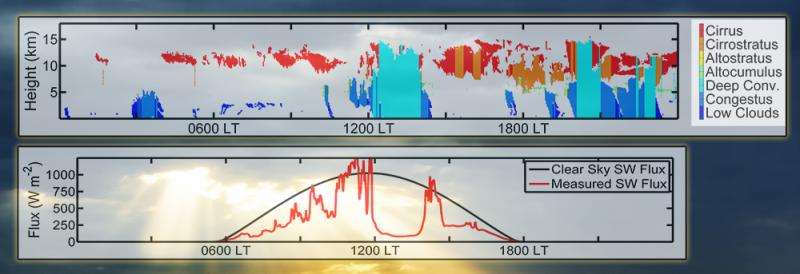Type and frequency of tropical clouds important for simulations of surface energy impact

Clouds are energy traffic cops, controlling how much sunlight reaches Earth. Pacific Northwest National Laboratory researchers used long-term observations to show that the sunlight stopping power of each type of typical tropical cloud and how frequently they occur must be accurately simulated in climate models. Otherwise, the true impact of clouds on the Earth's energy balance will be uncertain. Their research was published in the Journal of Applied Meteorology and Climatology.
While they found that tall storm clouds have the largest impact on the amount of incoming solar energy that reaches the surface, these are infrequent tropical visitors.
"We found that deep convective clouds' overall, or mean, impact is smaller compared to the more common shallow cumulus clouds," said Dr. Casey Burleyson, atmospheric scientist and lead author of the paper. "The research also found that a model producing too much or too little of a given type of cloud will have larger biases compared to a model that forms clouds at the wrong time of day."
Energy from the sun fuels Earth's heat engine. Cloud characteristics determine whether sunlight is either turned back toward space, bounced around the atmosphere like a demolition derby, or allowed to travel through to be soaked up by the Earth's surface.
To understand how clouds do this important job, scientists take measurements of energy from the sun (radiation) and cloud properties. But when it comes time to analyze clouds' role using climate simulations, many climate models fail to produce the right clouds in the right place at the right time. This means that the simulations often have large biases in how clouds impact the surface energy in/out balance. Model biases in the magnitude of these cloud radiative effects directly lead to uncertainty in future climate states projected by the models. The research in this work established clear physical targets that can be used to evaluate models and improve the simulation of clouds in climate models.

The PNNL team used long-term observations from the three Atmospheric Radiation Measurement (ARM) Climate Research Facility sites in the Tropical Western Pacific (TWP) region to quantify how each cloud type impacts the surface energy budget. Using the vertically-pointing radars and lidars, they determined the cloud type present at a given time and then related that dataset to longwave and shortwave radiative flux measurements made at the same time. This allowed them to attribute changes in the flux data to a specific type of cloud and then to determine which types of clouds have the largest conditional and mean impacts on the surface energy budget. The research showed how small errors in modeled cloud frequency could cause large biases in the surface energy budget simulated by the model.
The statistical analysis in this research was possible largely because of the long-term data record, in some cases over 20 years, that is available from the ARM sites in the tropical western Pacific region.
The analysis can be expanded to include other long-term ARM datasets from the Southern Great Plains or North Slope of Alaska ARM sites, gauging how each type of cloud behaves differently in various climate settings. The team will depict cloud radiative effects in both cloud-size and global climate models to see how well they can reproduce these results.
More information: "Quantifying Diurnal Cloud Radiative Effects by Cloud Type in the Tropical Western Pacific." Journal of Applied Meteorology and Climatology, early online. DOI: 10.1175/JAMC-D-14-0288.1
Provided by Pacific Northwest National Laboratory





















